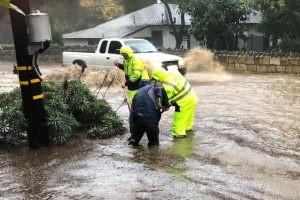“Now, when there’s smoke here, everybody panics,” said Steve Crowder, mayor of the small town of Paradise that was almost wiped off the map by California‘s deadly 2018 wildfires.
The former police officer still struggles to hold back tears when talking about the blaze that claimed dozens of lives and engulfed 95 percent of his community’s buildings.
“It’s still hard to get over the 85 people that didn’t get out,” he told AFP.
“It’s the most horrific thing that I’ve ever experienced in my life… I think fire terrorizes everybody here.”
Across California, deadly infernos have only expanded in size since that traumatic year — in 2020, some 4.3 million acres went up in smoke.
Now, the western US state is bracing for the worst as yet another dry summer approaches. Already five times more vegetation has burned this year compared to the same time last year.
“In the last 25 months, we’ve had 101 civilians perish in wildfires with over 21,000 structure destroyed within Butte County,” said John Messina, fire chief of the county where Paradise is located.
“That supersedes anything that California has seen in modern times” and serves as a warning, or “ground zero,” for what could lie ahead of the rest of the state, according to Messina.
“In the past, we may have had one fire in the summer that was notable,” he said. “Now 50 percent of our fires are notable — and what I mean by notable is something that really, really exceeded our expectations on growth and intensity.”
While fires are part of the natural cycle of California’s forests, the fire season is starting earlier and ending later each year.
Climate change is “is considered a key driver of this trend,” state fire officials note in their 2021 forecast, with the fire season lengthened by an estimated 75 days in part of the state.
For Messina, the concept of a summer and fall “fire season” is no longer meaningful.
“Fire season’s year round — we’re busier during a specific time, but the potential for wildfire exists throughout the year,” he said.
“We work our employees extremely hard in the summer for four, five, six, seven months, under the expectation that we’re going to give them a break in the wintertime and kind of reset.
“There is no reset any more in California.”
Also read: Arctic has warmed three times faster than Earth since 1971: Report
Making matters worse is the chronic lack of rainfall affecting California, in particular its northern counties.
“This year is another exceptional year when it comes to the potential — we are in a fairly significant drought,” said Messina, noting that vegetation is already extremely dry for so early in the year.
“All we need is the ignition now and then we have a problem. So we’re on high alert,” he said.
According to Crowder, vegetation around Paradise is like “a tinderbox,” having dried out months earlier than usual.
His town in northern California has taken several steps to avoid a repeat of the tragic 2018 “Camp Fire,” with homeowners required to clear brush, particularly around buildings, and to keep grass lawns cut to below four inches.
Firefighters are stepping up inspections to ensure the rules are being followed.
But the effort is made more difficult because only a few thousand of the town’s former 26,000 residents have moved back to Paradise since 2018’s mass evacuations. Many landowners are hard or impossible to reach.
“I’ve asked each one of them, if not for yourself, do it for your neighbor who’s left behind… we’re trying everything we can to make it a fire-safe town,” said the mayor.
While the area’s levels of flammable vegetation are well below pre-2018, “if we do nothing for the next 10 years, we’re going to be right back where we were,” he added.
A short drive from Paradise, the small community of Berry Creek lies on a hillside now charred by last September’s huge fire, which devastated the area and killed 15 people in the blink of an eye.
Unlike many other residents who lost everything to the flames, Jimmy has decided to move back to the town he first settled in 44 years ago.
The survivor, in his 60s, has spent nine months since the fire preparing to construct a pre-fabricated home, where he wants to live out his days.
He recently moved into a nearby trailer, and has carefully cleared away the brush as work on the foundations advances, using water from a borehole.
He has taken all possible measures to ensure that the new construction will be “a fire resistant house, with a metal roof and everything,” but admitted the events have taken a severe emotional toll.
“It’s taking years off my life — I’m tired.”






